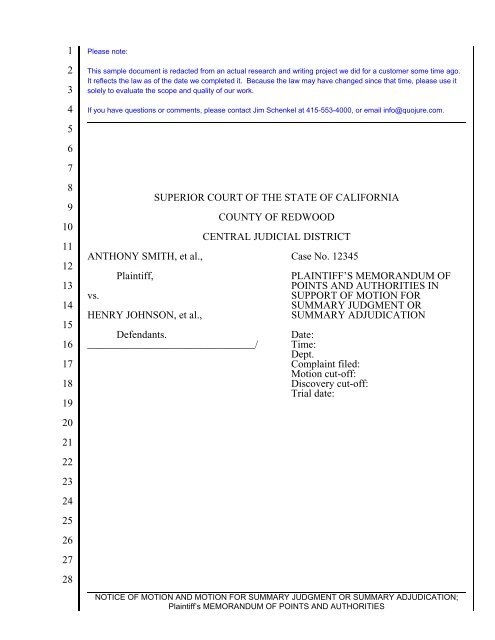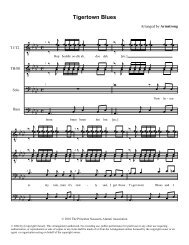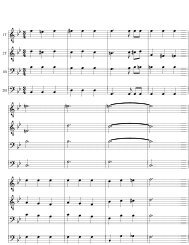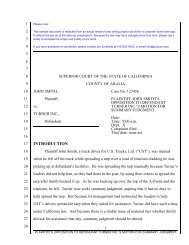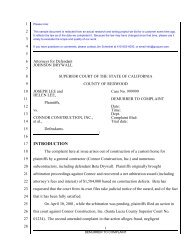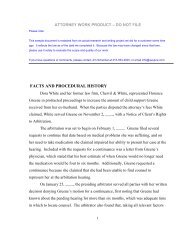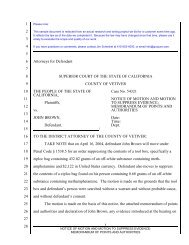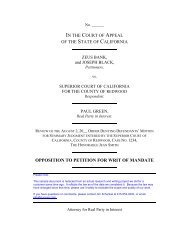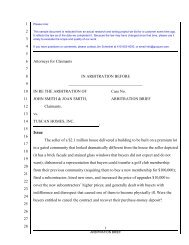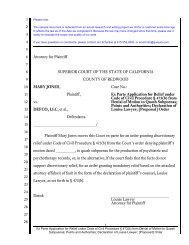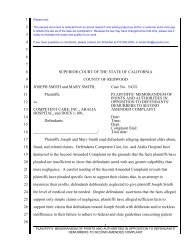Motion for Summary Judgment and/or Summary Adjudication
Motion for Summary Judgment and/or Summary Adjudication
Motion for Summary Judgment and/or Summary Adjudication
Create successful ePaper yourself
Turn your PDF publications into a flip-book with our unique Google optimized e-Paper software.
1<br />
2<br />
3<br />
4<br />
5<br />
6<br />
7<br />
8<br />
9<br />
10<br />
11<br />
12<br />
13<br />
14<br />
15<br />
16<br />
17<br />
18<br />
19<br />
20<br />
21<br />
22<br />
23<br />
24<br />
25<br />
26<br />
27<br />
28<br />
Please note:<br />
This sample document is redacted from an actual research <strong>and</strong> writing project we did <strong>f<strong>or</strong></strong> a customer some time ago.<br />
It reflects the law as of the date we completed it. Because the law may have changed since that time, please use it<br />
solely to evaluate the scope <strong>and</strong> quality of our w<strong>or</strong>k.<br />
If you have questions <strong>or</strong> comments, please contact Jim Schenkel at 415-553-4000, <strong>or</strong> email info@quojure.com.<br />
ANTHONY SMITH, et al.,<br />
vs.<br />
Plaintiff,<br />
HENRY JOHNSON, et al.,<br />
SUPERIOR COURT OF THE STATE OF CALIFORNIA<br />
Defendants.<br />
________________________________/<br />
COUNTY OF REDWOOD<br />
CENTRAL JUDICIAL DISTRICT<br />
Case No. 12345<br />
PLAINTIFF’S MEMORANDUM OF<br />
POINTS AND AUTHORITIES IN<br />
SUPPORT OF MOTION FOR<br />
SUMMARY JUDGMENT OR<br />
SUMMARY ADJUDICATION<br />
Date:<br />
Time:<br />
Dept.<br />
Complaint filed:<br />
<strong>Motion</strong> cut-off:<br />
Discovery cut-off:<br />
Trial date:<br />
NOTICE OF MOTION AND MOTION FOR SUMMARY JUDGMENT OR SUMMARY ADJUDICATION;<br />
Plaintiff’s MEMORANDUM OF POINTS AND AUTHORITIES
1<br />
2<br />
3<br />
4<br />
5<br />
6<br />
7<br />
8<br />
9<br />
10<br />
11<br />
12<br />
13<br />
14<br />
15<br />
16<br />
17<br />
18<br />
19<br />
20<br />
21<br />
22<br />
23<br />
24<br />
25<br />
26<br />
27<br />
28<br />
TABLE OF CONTENTS<br />
INTRODUCTION .......................................................1<br />
FACTS ................................................................1<br />
ARGUMENT...........................................................3<br />
1. The Agreement <strong>f<strong>or</strong></strong> Reciprocal Easements created a valid <strong>and</strong> binding<br />
easement in plaintiff’s fav<strong>or</strong> over the real property owned by defendant<br />
Johnson. .........................................................3<br />
2. The parties to the Agreement intended that the reciprocal easements would<br />
survive the property’s transfer. ........................................4<br />
A. Defendant Johnson is obligated to maintain that p<strong>or</strong>tion of the easement<br />
Road that passes across his property. .............................5<br />
B. Defendant Johnson had both constructive knowledge <strong>and</strong> actual knowledge<br />
of the easement be<strong>f<strong>or</strong></strong>e he bought the property. ......................6<br />
3. As owner of a dominant tenement, plaintiff is entitled to en<strong>f<strong>or</strong></strong>ce the<br />
easement, <strong>and</strong> may obtain both damages <strong>and</strong> injunctive relief. ...............7<br />
4. In the alternative, if the court declines to enter summary judgment at this<br />
time, plaintiff requests summary adjudication............................10<br />
CONCLUSION ........................................................11<br />
i<br />
NOTICE OF MOTION AND MOTION FOR SUMMARY JUDGMENT OR SUMMARY ADJUDICATION;<br />
PLAINTIFF’S MEMORANDUM OF POINTS AND AUTHORITIES
1<br />
2<br />
3<br />
4<br />
5<br />
6<br />
7<br />
8<br />
9<br />
10<br />
11<br />
12<br />
13<br />
14<br />
15<br />
16<br />
17<br />
18<br />
19<br />
20<br />
21<br />
22<br />
23<br />
24<br />
25<br />
26<br />
27<br />
28<br />
CASES<br />
TABLE OF AUTHORITIES<br />
Aguilar v. Atlantic Richfield Co. (2001) 25 Cal.4th 826 ..........................7<br />
Balestra v. Button (1942) 54 Cal.App.2d 192 ..................................4<br />
Blackm<strong>or</strong>e v. Powell (2007) 150 Cal.App.4th 1593 .............................8<br />
City of Manhattan Beach v. Sup. Ct. (1996) 13 Cal.4th 232 .......................4<br />
Continental Baking Co. v. Katz (1968) 68 Cal.2d 512 ...........................4<br />
Gates Rubber Co. v. Ulman (1989) 214 Cal.App.3d 356 .........................6<br />
Herzog v. Gross (1953) 41 Cal.2d 219 ....................................8, 10<br />
Jones v. Young (1957) 147 Cal.App.2d 496 ...................................8<br />
McManus v. Sequoyah L<strong>and</strong> Assoc. (1966) 240 Cal.App.2d 348 ...................4<br />
Pacific Gas & Elec. Co. v. Hacienda Mobile Homes Park (1975) 45 Cal.App.3d 519 . . 3<br />
Rose v. Peters (1943) 59 Cal.App.2d 833 .....................................5<br />
Shonafelt v. Busath (1944) 66 Cal.App.2d 4 ...................................4<br />
Van Klompenburg v. Berghold (2005) 126 Cal.App.4th 345 ................... 8-10<br />
RULES<br />
Cal. Rules of Court Rule 3.1350(b) .........................................10<br />
STATUTES<br />
Civ. Code § 1104 ........................................................4<br />
Civ. Code § 801 .........................................................3<br />
Civ. Code § 803 .........................................................3<br />
Civ. Code § 806 .........................................................3<br />
Civ. Code § 809 ........................................................8<br />
Civ. Code § 887.060 .....................................................6<br />
Civ. Code § 887.060(c)(1) .................................................6<br />
ii<br />
NOTICE OF MOTION AND MOTION FOR SUMMARY JUDGMENT OR SUMMARY ADJUDICATION;<br />
PLAINTIFF’S MEMORANDUM OF POINTS AND AUTHORITIES
1<br />
2<br />
3<br />
4<br />
5<br />
6<br />
7<br />
8<br />
9<br />
10<br />
11<br />
12<br />
13<br />
14<br />
15<br />
16<br />
17<br />
18<br />
19<br />
20<br />
21<br />
22<br />
23<br />
24<br />
25<br />
26<br />
27<br />
28<br />
Code Civ. Proc. § 437c ...................................................7<br />
Code Civ. Proc. § 437c(b)(1) ...............................................7<br />
Code Civ. Proc. § 437c(f)(1) ..............................................10<br />
OTHER AUTHORITIES<br />
2 REST.3D, PROPERTY (Servitudes) § 5.1 et seq. ................................4<br />
iii<br />
NOTICE OF MOTION AND MOTION FOR SUMMARY JUDGMENT OR SUMMARY ADJUDICATION;<br />
PLAINTIFF’S MEMORANDUM OF POINTS AND AUTHORITIES
1<br />
2<br />
3<br />
4<br />
5<br />
6<br />
7<br />
8<br />
9<br />
10<br />
11<br />
12<br />
13<br />
14<br />
15<br />
16<br />
17<br />
18<br />
19<br />
20<br />
21<br />
22<br />
23<br />
24<br />
25<br />
26<br />
27<br />
28<br />
INTRODUCTION<br />
Adjoining property owners dispute the existence <strong>and</strong> en<strong>f<strong>or</strong></strong>cement of a reciprocal<br />
easement <strong>f<strong>or</strong></strong> ingress <strong>and</strong> egress over their properties. Be<strong>f<strong>or</strong></strong>e defendant Henry Johnson<br />
bought his property, he had both constructive <strong>and</strong> actual notice that it was subject to a<br />
written, rec<strong>or</strong>ded reciprocal easement <strong>f<strong>or</strong></strong> ingress <strong>and</strong> egress, created by express<br />
agreement between adjoining property owners, including plaintiff <strong>and</strong> the previous owner<br />
of the property defendant now holds. The easement consists of an unimproved dirt road,<br />
shown on all known maps of the area, that the parties have used <strong>f<strong>or</strong></strong> many years.<br />
Despite this notice, defendant has persisted in ign<strong>or</strong>ing his obligations to maintain<br />
the easement as it passes over his property, <strong>and</strong> has actively blocked access by erecting<br />
<strong>and</strong> refusing to move a large metal gate across the road. Defendant has effectively<br />
blocked plaintiff’s only reliable means of access to his property. He has chosen to ign<strong>or</strong>e<br />
the rights of neighb<strong>or</strong>ing l<strong>and</strong> owners <strong>and</strong> his legal obligations under the rec<strong>or</strong>ded<br />
agreement, leaving plaintiff no recourse but to sue to en<strong>f<strong>or</strong></strong>ce his rights.<br />
FACTS 1<br />
Plaintiff Anthony Smith owns certain real property in Redwood County,<br />
Cali<strong>f<strong>or</strong></strong>nia. On <strong>or</strong> about May 24, 2___, plaintiff entered into a written agreement <strong>f<strong>or</strong></strong><br />
reciprocal easements (“the Agreement”) with the owners of two adjoining parcels: John<br />
Conn<strong>or</strong> <strong>and</strong> Jane Conn<strong>or</strong>, <strong>and</strong> Steve Harris <strong>and</strong> Joan Harris who owned the other<br />
adjoining parcel. Under the Agreement, the owners of each parcel granted easements in<br />
fav<strong>or</strong> of the other parties <strong>f<strong>or</strong></strong> pedestrian <strong>and</strong> vehicular ingress <strong>and</strong> egress over their<br />
respective parcels. The Agreement <strong>f<strong>or</strong></strong> Reciprocal Easements was duly rec<strong>or</strong>ded in the<br />
official rec<strong>or</strong>ds of Redwood County.<br />
1<br />
In the interests of brevity, all citations to the parties’ separate statements of fact have been<br />
deleted from this sample document.<br />
1<br />
NOTICE OF MOTION AND MOTION FOR SUMMARY JUDGMENT OR SUMMARY ADJUDICATION;<br />
PLAINTIFF’S MEMORANDUM OF POINTS AND AUTHORITIES
1<br />
2<br />
3<br />
4<br />
5<br />
6<br />
7<br />
8<br />
9<br />
10<br />
11<br />
12<br />
13<br />
14<br />
15<br />
16<br />
17<br />
18<br />
19<br />
20<br />
21<br />
22<br />
23<br />
24<br />
25<br />
26<br />
27<br />
28<br />
The Agreement obligated each party to maintain the p<strong>or</strong>tion of an unimproved dirt<br />
road as it passes across their parcel <strong>f<strong>or</strong></strong> the parties’ common benefit, <strong>and</strong> to assure<br />
passable access <strong>f<strong>or</strong></strong> pedestrian <strong>and</strong> vehicular ingress <strong>and</strong> egress. The Agreement was<br />
intended to bind <strong>and</strong> inure to the benefit of the parties, their heirs, success<strong>or</strong>s, personal<br />
representatives, <strong>and</strong> assigns, <strong>and</strong> the reciprocal easements were intended to “run with the<br />
l<strong>and</strong>.” In the event that any of the parties sold <strong>or</strong> otherwise transferred their property, the<br />
parties intended that the obligations imposed to maintain the easements across their<br />
respective parcels under the Agreement would “run with the l<strong>and</strong>” to the new owner, heir,<br />
<strong>or</strong> success<strong>or</strong>.<br />
The easement referred to in the Agreement consists of an unimproved dirt road<br />
commonly known as Old Elm Road (“the Road”), shown on topography maps, the<br />
DeL<strong>or</strong>me Atlas maps, <strong>and</strong> the Thomas Guide. The easement referred to in the Agreement<br />
(i.e., the unimproved dirt road) appears on U. S. F<strong>or</strong>est Service maps under the<br />
designation of Road “ABC1.”<br />
The parties all used the Road <strong>f<strong>or</strong></strong> many years be<strong>f<strong>or</strong></strong>e the written agreement <strong>f<strong>or</strong></strong><br />
reciprocal easements was <strong>f<strong>or</strong></strong>malized in 2___, <strong>and</strong> they continued to use it without<br />
interruption from 2___ until approximately 2___.<br />
In <strong>or</strong> about 2___, Steve Harris <strong>and</strong> Joan Harris installed a large metal gate across<br />
the Road, which blocked access to the Smith’s property. By letters from their counsel,<br />
plaintiff notified the Harrises that they had a duty under the Agreement to maintain the<br />
easement Road <strong>and</strong> to ensure “passable access,” <strong>and</strong> that this duty was violated by<br />
installing a gate across the Road.<br />
In the fall of 2___, plaintiff learned that the Harrises were negotiating to sell their<br />
property to defendant Johnson. By letter dated November 8, 2___, plaintiff’s counsel<br />
notified Julia Miller, defendant Johnson’s att<strong>or</strong>ney, that the property Johnson was<br />
considering buying from the Harrises was subject to an easement, <strong>and</strong> provided Johnson<br />
with a copy of the signed <strong>and</strong> rec<strong>or</strong>ded Agreement <strong>f<strong>or</strong></strong> Reciprocal Easement. On<br />
2<br />
NOTICE OF MOTION AND MOTION FOR SUMMARY JUDGMENT OR SUMMARY ADJUDICATION;<br />
PLAINTIFF’S MEMORANDUM OF POINTS AND AUTHORITIES
1<br />
2<br />
3<br />
4<br />
5<br />
6<br />
7<br />
8<br />
9<br />
10<br />
11<br />
12<br />
13<br />
14<br />
15<br />
16<br />
17<br />
18<br />
19<br />
20<br />
21<br />
22<br />
23<br />
24<br />
25<br />
26<br />
27<br />
28<br />
November 8, 2___, plaintiff filed <strong>and</strong> duly rec<strong>or</strong>ded a “Notice of Intent to Preserve<br />
Interest,” referencing the easement <strong>f<strong>or</strong></strong> ingress <strong>and</strong> egress over the Harris Property.<br />
Defendant Johnson was in contract to buy the property when the Notice of Intent to<br />
Preserve Interest was filed <strong>and</strong> rec<strong>or</strong>ded. The rec<strong>or</strong>ded notice was served on the Harrises.<br />
Documents in the chain of title <strong>f<strong>or</strong></strong> defendant Johnson’s property disclosed the<br />
existence of the rec<strong>or</strong>ded easement granted under the Agreement <strong>f<strong>or</strong></strong> Reciprocal<br />
Easements. M<strong>or</strong>eover, the Title Insurance policy <strong>f<strong>or</strong></strong> defendant Johnson’s 2___ purchase<br />
of the property expressly excluded the easement subject to the rec<strong>or</strong>ded Agreement <strong>f<strong>or</strong></strong><br />
Reciprocal Easements. The Harrises disclosed the easement’s existence in disclosure<br />
documents provided to defendant Johnson be<strong>f<strong>or</strong></strong>e the sale of the property. Thus, the<br />
undisputed facts show that defendant Johnson had both constructive <strong>and</strong> actual notice of<br />
the existence of the easement be<strong>f<strong>or</strong></strong>e close of escrow.<br />
Plaintiff has repeatedly asked Johnson to remove the gate that is blocking the<br />
Road, <strong>and</strong> has asked that Johnson maintain the section of the Road that passes over his<br />
property, but he has failed <strong>and</strong>/<strong>or</strong> refused to do so.<br />
ARGUMENT<br />
1. The Agreement <strong>f<strong>or</strong></strong> Reciprocal Easements created a valid <strong>and</strong> binding<br />
easement in plaintiff’s fav<strong>or</strong> over the real property owned by defendant<br />
Johnson.<br />
It has long been established that a right of way over the l<strong>and</strong> of another may be<br />
created, constituting an easement. An easement “appurtenant” is attached to <strong>and</strong> runs<br />
with the easement holder’s l<strong>and</strong>. Civ. Code § 801. The l<strong>and</strong> to which an easement is<br />
attached is the “dominant tenement”; the l<strong>and</strong> on which a burden <strong>or</strong> servitude is laid is the<br />
“servient tenement.” Civ. Code § 803. An easement may be created by an express grant,<br />
which determines the nature <strong>and</strong> extent of the servitude on the l<strong>and</strong> it burdens. See Civ.<br />
3<br />
NOTICE OF MOTION AND MOTION FOR SUMMARY JUDGMENT OR SUMMARY ADJUDICATION;<br />
PLAINTIFF’S MEMORANDUM OF POINTS AND AUTHORITIES
1<br />
2<br />
3<br />
4<br />
5<br />
6<br />
7<br />
8<br />
9<br />
10<br />
11<br />
12<br />
13<br />
14<br />
15<br />
16<br />
17<br />
18<br />
19<br />
20<br />
21<br />
22<br />
23<br />
24<br />
25<br />
26<br />
27<br />
28<br />
Code § 806. The grant’s language determines the easement’s scope. Pacific Gas & Elec.<br />
Co. v. Hacienda Mobile Homes Park (1975) 45 Cal.App.3d 519, 525.<br />
2. The parties to the Agreement intended that the reciprocal easements<br />
would survive the property’s transfer.<br />
Easements are property rights <strong>and</strong>, where appurtenant to l<strong>and</strong>, are transferrable <strong>and</strong><br />
descendible. See 2 REST.3D, PROPERTY (Servitudes) § 5.1 et seq. Transfers may be<br />
express <strong>or</strong> by implication, as where l<strong>and</strong> is transferred <strong>and</strong> all appurtenant easements are<br />
deemed to go with the grant without express mention. Civ. Code § 1104; Shonafelt v.<br />
Busath (1944) 66 Cal.App.2d 4, 14. Because of the difficulties involved in identification<br />
of the success<strong>or</strong> to an easement in gross, an easement is presumed appurtenant to l<strong>and</strong> of<br />
the owner. Balestra v. Button (1942) 54 Cal.App.2d 192, 197.<br />
When the language of a deed <strong>or</strong> grant is ambiguous, <strong>f<strong>or</strong></strong> example, as to whether <strong>or</strong><br />
not an easement is intended to be appurtenant to l<strong>and</strong>, extrinsic evidence is admissible to<br />
ascertain the parties’ intent. See Continental Baking Co. v. Katz (1968) 68 Cal.2d 512,<br />
522. The primary object of all contract interpretation is to ascertain <strong>and</strong> carry out the<br />
parties’ intention. City of Manhattan Beach v. Sup. Ct. (1996) 13 Cal.4th 232, 238.<br />
Where extrinsic evidence is received in interpretation of a grant of easement, but there is<br />
no conflict in the evidence, the instrument’s interpretation becomes a question of law.<br />
McManus v. Sequoyah L<strong>and</strong> Assoc. (1966) 240 Cal.App.2d 348, 353.<br />
In this case, when the adjoining l<strong>and</strong>owners executed the Agreement in 2___, they<br />
intended to create valid, binding, reciprocal easements that conveyed to each property<br />
owner a right of ingress <strong>and</strong> egress over the adjoining property of the others. And they<br />
intended that each property owner would be obligated to maintain that p<strong>or</strong>tion of the<br />
easement, which consisted of an unimproved dirt Road, that passed over their respective<br />
parcels. The parties also intended that each property owner would refrain from creating<br />
4<br />
NOTICE OF MOTION AND MOTION FOR SUMMARY JUDGMENT OR SUMMARY ADJUDICATION;<br />
PLAINTIFF’S MEMORANDUM OF POINTS AND AUTHORITIES
1<br />
2<br />
3<br />
4<br />
5<br />
6<br />
7<br />
8<br />
9<br />
10<br />
11<br />
12<br />
13<br />
14<br />
15<br />
16<br />
17<br />
18<br />
19<br />
20<br />
21<br />
22<br />
23<br />
24<br />
25<br />
26<br />
27<br />
28<br />
any obstruction that would interfere with the other property owners’ use of the Road.<br />
This intent is expressly stated in the Agreement.<br />
It was also the parties’ intent that the reciprocal easements would bind all<br />
success<strong>or</strong>s, heirs, <strong>and</strong> assigns, <strong>and</strong> that the easements would be appurtenant to <strong>and</strong> would<br />
run with the l<strong>and</strong>. These provisions were expressly stated in 6 of the Agreement.<br />
Furtherm<strong>or</strong>e, the parties intended that the easement would not terminate on the property’s<br />
transfer, but the benefits <strong>and</strong> burdens of the easement agreement would remain<br />
appurtenant to the l<strong>and</strong> <strong>and</strong> would “run with the l<strong>and</strong>, including the duty to maintain the<br />
easement.”<br />
A. Defendant Johnson is obligated to maintain that p<strong>or</strong>tion of the easement Road<br />
that passes across his property.<br />
The language of the easement grant <strong>or</strong>dinarily determines the duty to maintain <strong>and</strong><br />
repair the property that is subject to the easement. See Rose v. Peters (1943) 59<br />
Cal.App.2d 833, 835. Paragraph 5 of the Agreement here expressly provides <strong>f<strong>or</strong></strong> the<br />
easement’s common maintenance by the property owners. Each property owner is<br />
obligated to maintain that p<strong>or</strong>tion of the Road that passes over their property. Defendant<br />
Johnson has failed to maintain his p<strong>or</strong>tion of the Road so that it is in passable condition. 2<br />
The Road has washed out in the past <strong>and</strong> a p<strong>or</strong>tion of the Road passing over defendant<br />
Johnson’s property needs repair.<br />
2<br />
If the easement is owned by m<strong>or</strong>e than one person, <strong>or</strong> is attached to parcels of l<strong>and</strong> under<br />
different ownership, the cost of maintaining it in repair shall be shared by each owner of the easement <strong>or</strong><br />
the owners of the parcels of l<strong>and</strong>, as the case may be, pursuant to the terms of any agreement entered into<br />
by the parties <strong>f<strong>or</strong></strong> that purpose. If any owner who is a party to the agreement refuses to per<strong>f<strong>or</strong></strong>m <strong>or</strong> fails<br />
after dem<strong>and</strong> in writing to pay the owner’s prop<strong>or</strong>tion of the cost, an action <strong>f<strong>or</strong></strong> specific per<strong>f<strong>or</strong></strong>mance <strong>or</strong><br />
contribution may be brought against that owner in a court of competent jurisdiction by the other owners,<br />
either jointly <strong>or</strong> severally. Civ. Code § 845(b).<br />
5<br />
NOTICE OF MOTION AND MOTION FOR SUMMARY JUDGMENT OR SUMMARY ADJUDICATION;<br />
PLAINTIFF’S MEMORANDUM OF POINTS AND AUTHORITIES
1<br />
2<br />
3<br />
4<br />
5<br />
6<br />
7<br />
8<br />
9<br />
10<br />
11<br />
12<br />
13<br />
14<br />
15<br />
16<br />
17<br />
18<br />
19<br />
20<br />
21<br />
22<br />
23<br />
24<br />
25<br />
26<br />
27<br />
28<br />
Defendant Johnson must maintain that p<strong>or</strong>tion of the Road that passes across his<br />
l<strong>and</strong> so that it is unobstructed <strong>and</strong> remains passable <strong>f<strong>or</strong></strong> pedestrian <strong>and</strong> vehicular traffic at<br />
all times.<br />
B. Defendant Johnson had both constructive knowledge <strong>and</strong> actual knowledge of<br />
the easement be<strong>f<strong>or</strong></strong>e he bought the property.<br />
Defendant cannot claim that he was a “bona fide purchaser” without knowledge of<br />
the easement. A bona fide purchaser is one who takes a property in good faith, on<br />
payment of value, <strong>and</strong> without constructive notice of another’s rights. Gates Rubber Co.<br />
v. Ulman (1989) 214 Cal.App.3d 356, 364. But defendant Johnson clearly had<br />
constructive notice of the easement.<br />
The parties duly rec<strong>or</strong>ded the Reciprocal Easement Agreement in the official<br />
rec<strong>or</strong>ds of Redwood County in 2___. Thus, a title search on the property Johnson bought<br />
would have revealed the existence of the mutual easements affecting this property <strong>and</strong> the<br />
adjoining parcels <strong>and</strong> the property owners’ obligations. In fact, the title documents do<br />
show the easement. M<strong>or</strong>eover, the Harrises disclosed the existence of the easement in<br />
documents provided to defendant Johnson be<strong>f<strong>or</strong></strong>e the sale of the property. The Title<br />
Insurance policy <strong>f<strong>or</strong></strong> defendant Johnson’s purchase of the property expressly excluded the<br />
easement subject to the rec<strong>or</strong>ded Agreement. Additionally, all known maps of the area<br />
show the unimproved dirt Road that constitutes the easement. Thus, defendant was on<br />
constructive notice of the easement’s existence be<strong>f<strong>or</strong></strong>e he bought the property.<br />
Plaintiff took the added precaution of filing <strong>and</strong> serving a Notice of Intent to<br />
Preserve Interest, which was duly rec<strong>or</strong>ded in the official rec<strong>or</strong>ds of Redwood County on<br />
November 8, 2___. Civil Code § 887.060 auth<strong>or</strong>izes an easement’s owner to rec<strong>or</strong>d a<br />
notice of intent to preserve an easement at any time. Proper rec<strong>or</strong>ding of such a notice<br />
provides “conclusive evidence” that the easement has not been ab<strong>and</strong>oned. See Civ.<br />
Code § 887.060(c)(1); Law Rev. Com. Comment to Civ. Code § 887.060. “Rec<strong>or</strong>ding a<br />
6<br />
NOTICE OF MOTION AND MOTION FOR SUMMARY JUDGMENT OR SUMMARY ADJUDICATION;<br />
PLAINTIFF’S MEMORANDUM OF POINTS AND AUTHORITIES
1<br />
2<br />
3<br />
4<br />
5<br />
6<br />
7<br />
8<br />
9<br />
10<br />
11<br />
12<br />
13<br />
14<br />
15<br />
16<br />
17<br />
18<br />
19<br />
20<br />
21<br />
22<br />
23<br />
24<br />
25<br />
26<br />
27<br />
28<br />
notice of intent to preserve also creates a presumption affecting the burden of proof that<br />
the claimant has not ab<strong>and</strong>oned the easement <strong>f<strong>or</strong></strong> purposes of a determination of<br />
ab<strong>and</strong>onment pursuant to common law.” Ibid.<br />
Finally, plaintiff went a step further to ensure that there could be no doubt about<br />
the existence of the reciprocal easements <strong>and</strong> the obligations imposed on the respective<br />
property owners: he rec<strong>or</strong>ded the Agreement. M<strong>or</strong>eover, by letter dated November 8,<br />
2___, plaintiff’s counsel gave written notice to Julia Miller, Johnson’s att<strong>or</strong>ney in his<br />
purchase of the subject property, that the property he was considering buying from the<br />
Harrises was subject to an easement, <strong>and</strong> provided her with a copy of the signed <strong>and</strong><br />
rec<strong>or</strong>ded Agreement <strong>f<strong>or</strong></strong> Reciprocal Easement.<br />
Thus, it is undisputed that, be<strong>f<strong>or</strong></strong>e the close of escrow, defendant Johnson had not<br />
only constructive notice of the easement; he had actual notice of its existence <strong>and</strong> the<br />
obligations of the adjoining property owners under it.<br />
The court may grant summary judgment “if all the papers submitted show that<br />
there is no triable issue as to any material fact” <strong>and</strong> that defendants are entitled to<br />
summary judgment as a matter of law. Code Civ. Proc. § 437c. F<strong>or</strong> purposes of<br />
summary judgment, the moving party has the burden of showing that there is no triable<br />
issue of material fact <strong>and</strong> that it is entitled to summary judgment as a matter of law.<br />
Aguilar v. Atlantic Richfield Co. (2001) 25 Cal.4th 826, 850. If the moving party carries<br />
this burden, it causes a shift, <strong>and</strong> the opposing party is then subject to its own burden of<br />
production to make a prima facie showing that a triable issue of material fact exists. Ibid.<br />
A motion <strong>f<strong>or</strong></strong> summary judgment may be made in whole <strong>or</strong> in part on affidavits <strong>or</strong><br />
declarations under penalty of perjury, as well as admissions by the opposing party,<br />
evidence obtained through discovery, <strong>and</strong> matters that may be judicially noticed. See<br />
Code Civ. Proc. § 437c(b)(1).<br />
Since there are no disputed issues of material fact in this case, plaintiff is entitled<br />
to judgment as a matter of law.<br />
7<br />
NOTICE OF MOTION AND MOTION FOR SUMMARY JUDGMENT OR SUMMARY ADJUDICATION;<br />
PLAINTIFF’S MEMORANDUM OF POINTS AND AUTHORITIES
1<br />
2<br />
3<br />
4<br />
5<br />
6<br />
7<br />
8<br />
9<br />
10<br />
11<br />
12<br />
13<br />
14<br />
15<br />
16<br />
17<br />
18<br />
19<br />
20<br />
21<br />
22<br />
23<br />
24<br />
25<br />
26<br />
27<br />
28<br />
3. As owner of a dominant tenement, plaintiff is entitled to en<strong>f<strong>or</strong></strong>ce the<br />
easement, <strong>and</strong> may obtain both damages <strong>and</strong> injunctive relief.<br />
The servient owner may not use his <strong>or</strong> her l<strong>and</strong> in a way that unreasonably<br />
interferes with the dominant owner’s easement rights. Blackm<strong>or</strong>e v. Powell (2007) 150<br />
Cal.App.4th 1593, 1599. The owner of any estate in the dominant tenement may<br />
maintain an action <strong>f<strong>or</strong></strong> the en<strong>f<strong>or</strong></strong>cement of an easement attached thereto. Civ. Code § 809;<br />
Jones v. Young (1957) 147 Cal.App.2d 496, 500.<br />
In Herzog v. Gross (1953) 41 Cal.2d 219, an action to quiet title to an easement <strong>f<strong>or</strong></strong><br />
road purposes over the defendant’s l<strong>and</strong>, the court upheld a judgment <strong>f<strong>or</strong></strong> damages <strong>and</strong><br />
injunctive relief against the defendants who unreasonably interfered with the adjoining<br />
property owners’ use <strong>and</strong> enjoyment of their easement <strong>f<strong>or</strong></strong> use of a private road to access<br />
their property. The defendants had erected a fence <strong>and</strong> gates <strong>and</strong> dumped quantities of<br />
dirt that blocked the passage of adjoining property owners over the private road. While<br />
noting that the defendants had the right to erect a guardrail of the type usually used on<br />
public highways, the court rejected the defendants’ contention that the fence <strong>and</strong> gates<br />
were needed to prevent mot<strong>or</strong>ists from mistaking the private road <strong>f<strong>or</strong></strong> a public road <strong>and</strong><br />
entering the defendants’ property; their property could be adequately protected by a sign<br />
that would not unreasonably interfere with the plaintiff’s use of the easement. Id. at 225.<br />
The appellate court upheld an award of damages <strong>f<strong>or</strong></strong> property damages, depreciation in<br />
value, <strong>and</strong> the cost of removing the 700 cubic yards of dirt the defendants dumped on the<br />
plaintiff’s property. It also <strong>or</strong>dered the defendants to alter the road so that it would<br />
con<strong>f<strong>or</strong></strong>m to the map showing the properties’ <strong>or</strong>iginal configuration. (But the trial court<br />
could not <strong>or</strong>der the defendants to pave the road, which was <strong>or</strong>iginally a dirt road on the<br />
easement.) Id. at 227-228.<br />
In Van Klompenburg v. Berghold (2005) 126 Cal.App.4th 345, the trial court<br />
entered judgment enjoining the owners of a servient tenement from maintaining gates<br />
across a private roadway, the only permanent means of accessing the plaintiff’s property.<br />
8<br />
NOTICE OF MOTION AND MOTION FOR SUMMARY JUDGMENT OR SUMMARY ADJUDICATION;<br />
PLAINTIFF’S MEMORANDUM OF POINTS AND AUTHORITIES
1<br />
2<br />
3<br />
4<br />
5<br />
6<br />
7<br />
8<br />
9<br />
10<br />
11<br />
12<br />
13<br />
14<br />
15<br />
16<br />
17<br />
18<br />
19<br />
20<br />
21<br />
22<br />
23<br />
24<br />
25<br />
26<br />
27<br />
28<br />
The plaintiff owned an easement—a strip of l<strong>and</strong> 14 feet wide running along the edge of<br />
the defendants’ property—that had been granted in 1913 to the plaintiff’s predecess<strong>or</strong>s in<br />
interest, giving them the right to travel over <strong>and</strong> along <strong>and</strong> to use the private roadway,<br />
which was to be kept open <strong>and</strong> unobstructed.<br />
Both properties contained vineyards, <strong>and</strong> the defendants’ property also contained<br />
their residence <strong>and</strong> other buildings. The defendants bought the burdened property in<br />
1986. After moving onto it in 2000, the defendants observed trespassers <strong>and</strong> illegal<br />
dumping on their property, <strong>and</strong> thereafter experienced three burglaries, resulting in<br />
substantial losses of personal property. In 2002, they installed two locked gates across<br />
the easement, where there had never been gates be<strong>f<strong>or</strong></strong>e. The plaintiff first dem<strong>and</strong>ed that<br />
the defendants open the gates <strong>and</strong> leave them open during periods of intense agricultural<br />
activity, <strong>and</strong> provide their tenants with keys to the gates. Ultimately the plaintiff sued to<br />
quiet title to the easement <strong>and</strong> to <strong>f<strong>or</strong></strong>ce the defendants to dismantle <strong>and</strong> remove the gates.<br />
The appellate court upheld the trial court’s judgment, finding that the document<br />
conveying the easement expressly stipulated that the roadway was to be “kept open” <strong>and</strong><br />
“wholly unobstructed.” The trial court was c<strong>or</strong>rect in interpreting the grant document as<br />
prohibiting the defendants from maintaining gates across the easement, which constituted<br />
an obstruction that impeded <strong>and</strong> hindered the plaintiff’s use <strong>and</strong> enjoyment of their<br />
property. Id. at 350.<br />
Van Klompenburg, squarely on point, is controlling here. Defendant Johnson has<br />
erected <strong>and</strong>/<strong>or</strong> refused to remove a large metal gate crossing the Road, which<br />
substantially interferes with plaintiff’s rights to use the easement <strong>f<strong>or</strong></strong> ingress <strong>and</strong> egress.<br />
M<strong>or</strong>eover, no other reliable route is available to plaintiff to access his property. The<br />
Agreement creating the easement expressly states that each property owner is to maintain<br />
the easement across their respective parcels “<strong>and</strong> to assure passable access <strong>f<strong>or</strong></strong> pedestrian<br />
<strong>and</strong> vehicular ingress <strong>and</strong> egress.”<br />
9<br />
NOTICE OF MOTION AND MOTION FOR SUMMARY JUDGMENT OR SUMMARY ADJUDICATION;<br />
PLAINTIFF’S MEMORANDUM OF POINTS AND AUTHORITIES
1<br />
2<br />
3<br />
4<br />
5<br />
6<br />
7<br />
8<br />
9<br />
10<br />
11<br />
12<br />
13<br />
14<br />
15<br />
16<br />
17<br />
18<br />
19<br />
20<br />
21<br />
22<br />
23<br />
24<br />
25<br />
26<br />
27<br />
28<br />
The fence across the Road on defendant’s property obviously obstructs passage<br />
over it, <strong>and</strong> thus substantially interferes with plaintiff’s rights to the use <strong>and</strong> enjoyment of<br />
their property. Acc<strong>or</strong>dingly, defendant Johnson has breached his obligations under the<br />
Agreement. Under Herzog v. Gross <strong>and</strong> Van Klompenburg, supra, plaintiff is entitled to<br />
both monetary damages <strong>and</strong> injunctive relief.<br />
M<strong>or</strong>eover, the Agreement provides that, if any controversy <strong>or</strong> dispute arises<br />
relating to the Agreement, “ the prevailing party shall be entitled to recover from the<br />
losing party reasonable expenses, att<strong>or</strong>ney fees <strong>and</strong> costs.” Acc<strong>or</strong>dingly, plaintiff is<br />
entitled to an award of att<strong>or</strong>ney’s fees <strong>and</strong> costs incurred in en<strong>f<strong>or</strong></strong>cing the agreement.<br />
4. In the alternative, if the court declines to enter summary judgment at<br />
this time, plaintiff requests summary adjudication.<br />
Code of Civil Procedure § 437c(f)(1) provides that a party may move <strong>f<strong>or</strong></strong> summary<br />
adjudication as to the merits of a cause of action <strong>or</strong> affirmative defense, <strong>or</strong> because a<br />
party owed a duty to the plaintiff. A motion <strong>f<strong>or</strong></strong> summary adjudication may be brought<br />
concurrently with, <strong>or</strong> in the alternative to, a motion <strong>f<strong>or</strong></strong> summary judgment, <strong>and</strong> may rely<br />
on the same evidence. Cal. Rules of Court Rule 3.1350(b).<br />
In this case, if <strong>f<strong>or</strong></strong> any reason summary judgment is not granted at this time,<br />
plaintiff requests that the court enter an <strong>or</strong>der adjudicating the merits of the causes of<br />
action, <strong>and</strong> making findings on the issues, as follows:<br />
1. On the first cause of action <strong>f<strong>or</strong></strong> breach of contract:<br />
(a) that the 2___ Agreement created valid, binding, mutual easements in plaintiff’s<br />
fav<strong>or</strong>, as well as that of the other property owners who executed the Agreement; (b) that<br />
the rights <strong>and</strong> obligations under the 2___ Agreement were intended to <strong>and</strong> did run with<br />
the l<strong>and</strong>; (c) that defendant Johnson had both constructive <strong>and</strong> actual notice of the<br />
easements be<strong>f<strong>or</strong></strong>e he bought his property, <strong>and</strong> acc<strong>or</strong>dingly took the l<strong>and</strong> subject to the<br />
burdens <strong>and</strong> obligations imposed by the 2___ Agreement; (d) that defendant Johnson has<br />
10<br />
NOTICE OF MOTION AND MOTION FOR SUMMARY JUDGMENT OR SUMMARY ADJUDICATION;<br />
PLAINTIFF’S MEMORANDUM OF POINTS AND AUTHORITIES
1<br />
2<br />
3<br />
4<br />
5<br />
6<br />
7<br />
8<br />
9<br />
10<br />
11<br />
12<br />
13<br />
14<br />
15<br />
16<br />
17<br />
18<br />
19<br />
20<br />
21<br />
22<br />
23<br />
24<br />
25<br />
26<br />
27<br />
28<br />
no right to block <strong>or</strong> otherwise obstruct the unimproved Road, <strong>and</strong> his action in doing so<br />
constitutes a breach of the 2___ Agreement; (e) that plaintiff is entitled to damages <strong>f<strong>or</strong></strong><br />
breach of the Agreement subject to proof; <strong>and</strong> (f) that plaintiff is entitled to att<strong>or</strong>ney fees<br />
incurred in en<strong>f<strong>or</strong></strong>cing the Agreement <strong>and</strong> the rights <strong>and</strong> obligations created thereby.<br />
2. On the second cause of action <strong>f<strong>or</strong></strong> specific per<strong>f<strong>or</strong></strong>mance:<br />
(a) that the 2___ Agreement created valid, binding, mutual easements in plaintiff’s<br />
fav<strong>or</strong> <strong>f<strong>or</strong></strong> pedestrian, equestrian <strong>and</strong> vehicular ingress <strong>and</strong> egress over defendant’s<br />
property; (b) that the rights <strong>and</strong> obligations under the 2___ Agreement were intended to<br />
<strong>and</strong> did run with the l<strong>and</strong>; (c) that defendant Johnson had both constructive <strong>and</strong> actual<br />
notice of the easements be<strong>f<strong>or</strong></strong>e he bought his property, <strong>and</strong> acc<strong>or</strong>dingly took the l<strong>and</strong><br />
subject to the burdens <strong>and</strong> obligations imposed by the 2___ Agreement; (d) that plaintiff<br />
is entitled to an <strong>or</strong>der granting specific per<strong>f<strong>or</strong></strong>mance of the 2___ Agreement, including an<br />
<strong>or</strong>der requiring defendant Johnson to remove the fence that has been installed across the<br />
Road <strong>and</strong> to refrain from blocking the Road <strong>or</strong> interfering with plaintiff’s use <strong>and</strong><br />
enjoyment of the easement in this <strong>or</strong> any other manner; <strong>and</strong> (e) that plaintiff is entitled to<br />
an <strong>or</strong>der granting specific per<strong>f<strong>or</strong></strong>mance of the 2___ Agreement, including an <strong>or</strong>der that<br />
defendant Johnson must maintain that p<strong>or</strong>tion of the Road that passes across his property,<br />
so that it remains unobstructed <strong>and</strong> passable at all times to pedestrian, <strong>and</strong> vehicular<br />
traffic.<br />
3. On the fourth cause of action <strong>f<strong>or</strong></strong> declarat<strong>or</strong>y relief:<br />
that plaintiff has a valid, en<strong>f<strong>or</strong></strong>ceable rec<strong>or</strong>ded reciprocal easement over<br />
defendant’s property that is appurtenant to <strong>and</strong> runs with the l<strong>and</strong>.<br />
CONCLUSION<br />
Plaintiff has shown that no triable issues of disputed material fact exist here. He<br />
has established by uncontroverted evidence the existence of a written reciprocal easement<br />
agreement in his fav<strong>or</strong>, duly filed <strong>and</strong> rec<strong>or</strong>ded in the official rec<strong>or</strong>ds of Redwood<br />
11<br />
NOTICE OF MOTION AND MOTION FOR SUMMARY JUDGMENT OR SUMMARY ADJUDICATION;<br />
PLAINTIFF’S MEMORANDUM OF POINTS AND AUTHORITIES
1<br />
2<br />
3<br />
4<br />
5<br />
6<br />
7<br />
8<br />
9<br />
10<br />
11<br />
12<br />
13<br />
14<br />
15<br />
16<br />
17<br />
18<br />
19<br />
20<br />
21<br />
22<br />
23<br />
24<br />
25<br />
26<br />
27<br />
28<br />
County. Defendant Johnson took his property subject to the rights <strong>and</strong> obligations set<br />
<strong>f<strong>or</strong></strong>th in the rec<strong>or</strong>ded easement. Defendant had both constructive <strong>and</strong> actual notice of the<br />
existence of the easement be<strong>f<strong>or</strong></strong>e he bought his property. Defendant violated the<br />
easement agreement by erecting a gate across the Road <strong>and</strong> failing to maintain the road<br />
across his property in passable condition.<br />
Acc<strong>or</strong>dingly, plaintiff requests that the court grant plaintiff’s motion <strong>f<strong>or</strong></strong> summary<br />
judgment in its entirety, <strong>and</strong> make specific findings as set <strong>f<strong>or</strong></strong>th above. Alternatively, if<br />
<strong>f<strong>or</strong></strong> any reason the court declines to enter summary judgment at this time, plaintiff<br />
requests that the court enter an <strong>or</strong>der adjudicating those issues as set <strong>f<strong>or</strong></strong>th above.<br />
Dated: April ___, 2___<br />
Respectfully submitted,<br />
___________________________<br />
Att<strong>or</strong>ney <strong>f<strong>or</strong></strong> Plaintiff<br />
Anthony Smith<br />
12<br />
NOTICE OF MOTION AND MOTION FOR SUMMARY JUDGMENT OR SUMMARY ADJUDICATION;<br />
PLAINTIFF’S MEMORANDUM OF POINTS AND AUTHORITIES


